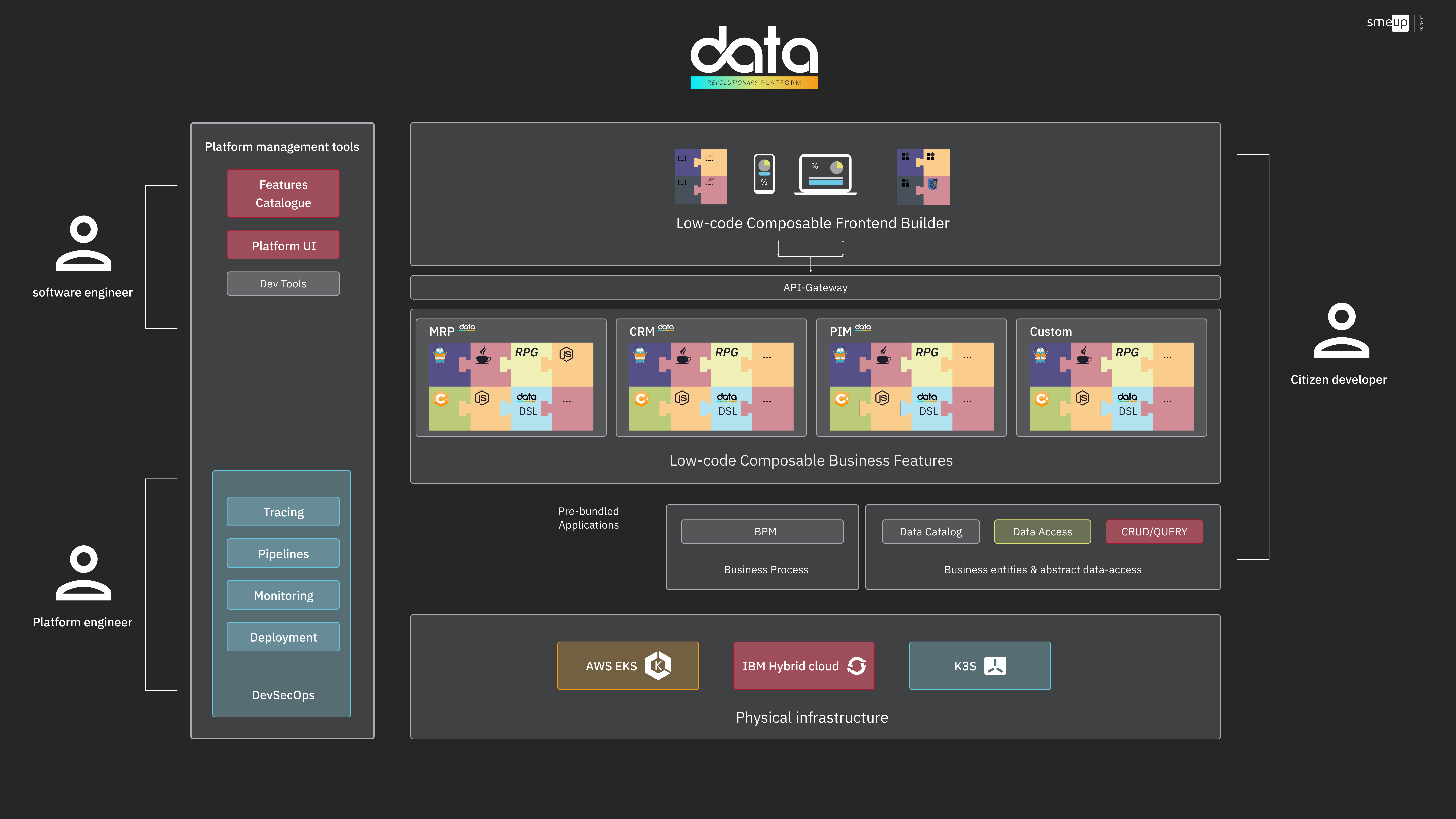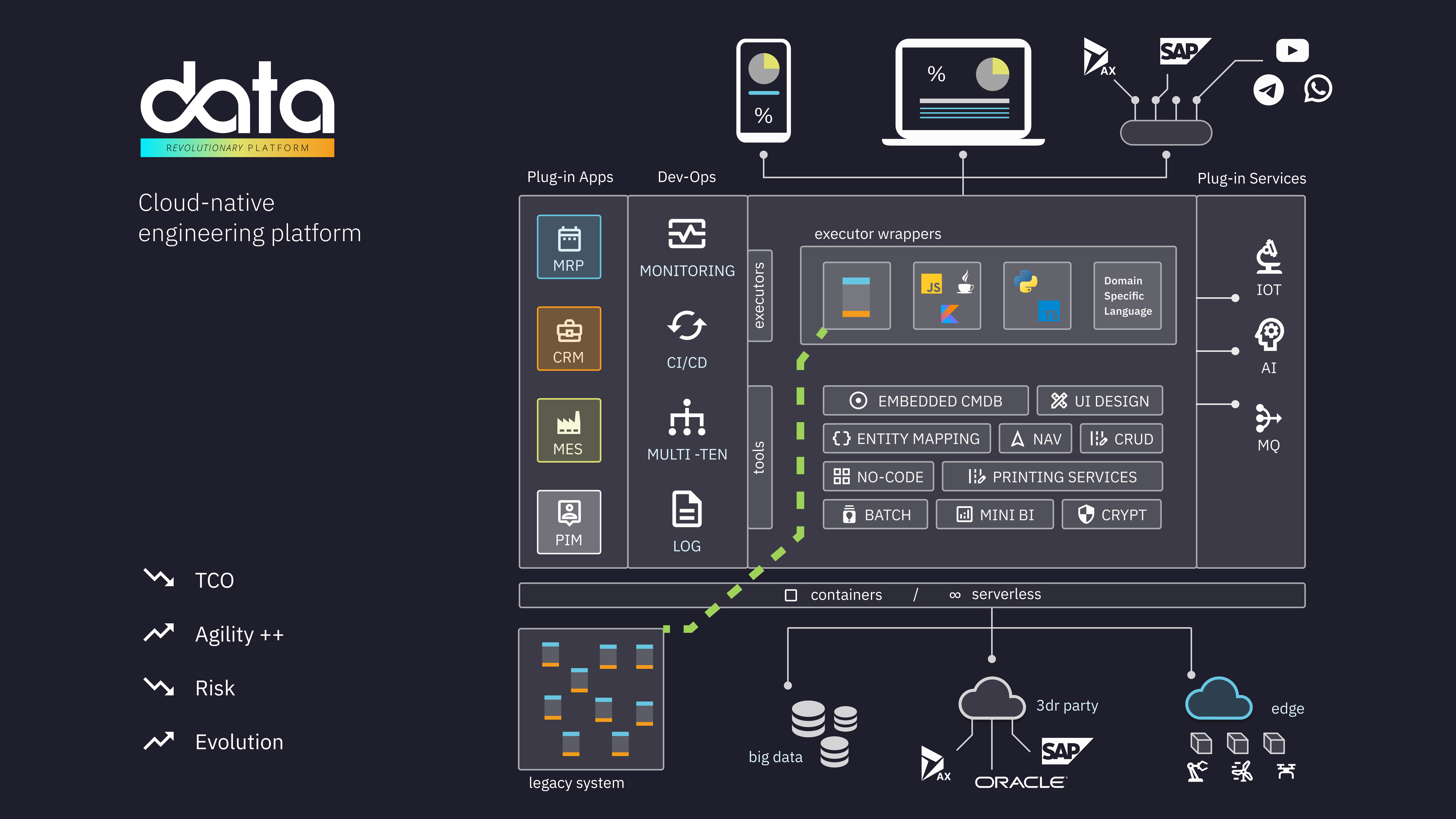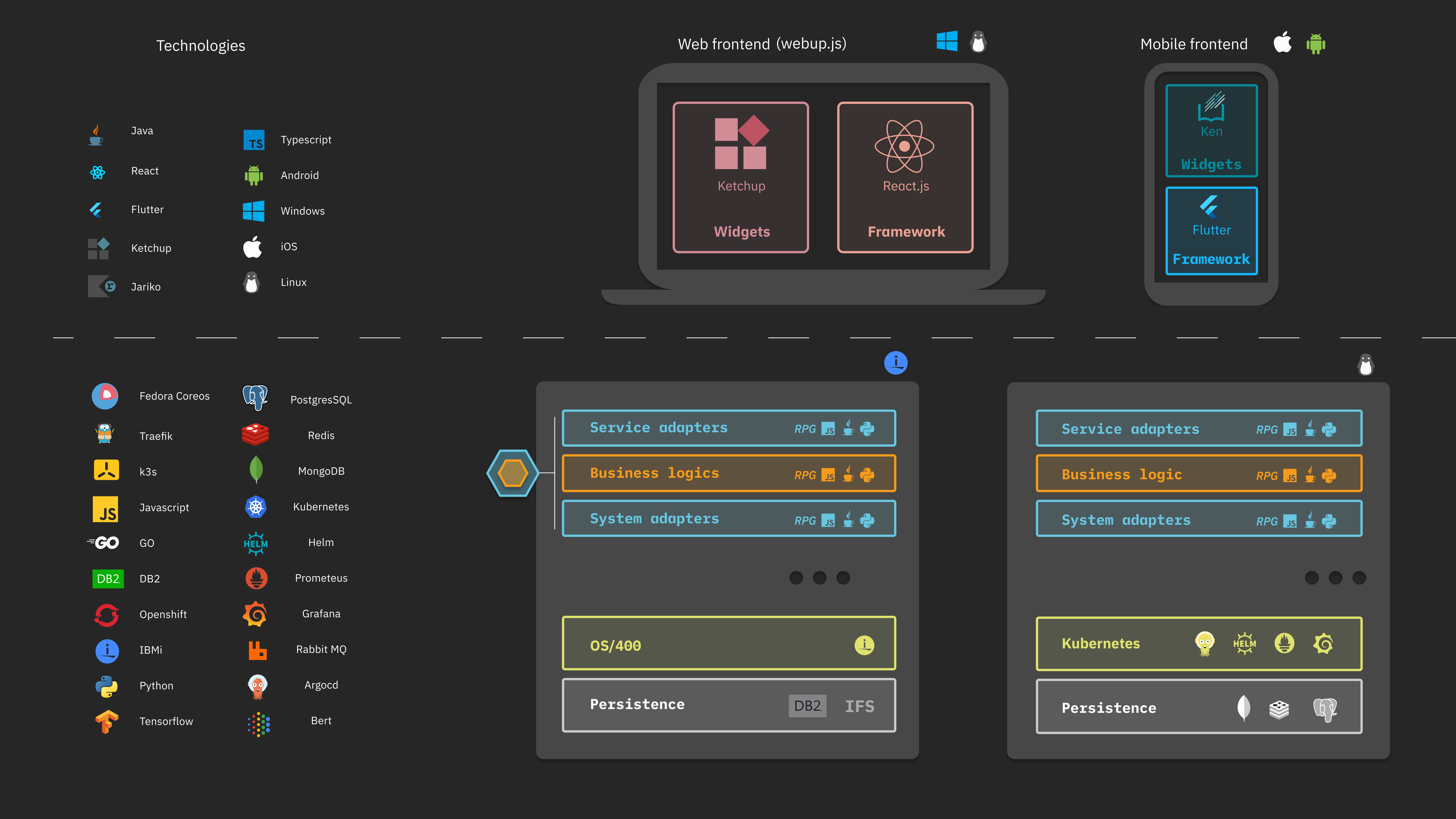Data out of the box
Executive summary
Data – A Platform for Accelerating Enterprise Application Development
Data is a cutting-edge software platform built around domain-specific languages (DSLs), designed to empower citizen developers to create robust enterprise applications without requiring expertise in traditional programming languages. Through its DSLs, Data offers an intuitive, building-block approach to configuring and composing applications, making enterprise-grade software development accessible to a broader audience.
The “solutions” (topics) offered by Data are:
- Cross-platform DLS-based development platform
- IBMi application futurization and migration
- Entity-based, event-based integration hub
Benefits for Enterprises
- Accelerated Development
DSLs and pre-built components streamline application creation for citizen developers. - Future-Proof Applications
Tools are updated seamlessly, ensuring compatibility without rework. - Customization and Extensibility
Advanced users can extend functionality with custom tools and integrations. - Comprehensive Lifecycle Management
From development to deployment and monitoring, Data provides end-to-end solutions. - Open and Scalable
Built for openness, allowing integration with existing and new technologies.
Data is not just a platform; it is a transformation enabler for enterprises, bridging the gap between technical and non-technical teams while ensuring scalability, security, and modernization.
Modules (UPPs)
Backend:
- [DataDevkit] Developer Tools: environment management, ci/cd, source control, source management
- [Jariko] Jariko and Reload: RPG interpreter
- [DataDBM] Database management and migration
- [Fire] Events and Workflow
- [DataIOT] IoT/Industrial IOT
- [Wanderlust] Entity-based framework: entities, navigation, CRUD operations, aggregations; actually all standard-released components such as “Schedas” and services
- [DataFoundry] Functions: Authentication, Authorization,I18n, DSL
- [DataAPI] Web APIs: REST, GraphQL, webhooks
- [Reports] Reporting: spreadsheets, pdfs and printouts
- [DAM] Digital Asset Management: shares, http locations, cdn
Frontend:
- [Webup] Web Framework and Widgets: dynamisms, toolbars, setups, additional columns, tooltips, filters, groupings, component switching, ux, etc.
- [Shiro] Native Mobile Frameworks and Widgets
Deployment:
- [AHD] Installers: AHD-vm, AHD-cloud, and SMEDEV
- [Observe] Observability tools
- [Telemetry] Remote Telemetry for Installations’ Data Collection
Key Features and Capabilities
Built-in User Interface
Data provides tools for creating modern, user-centric interfaces, including:
- Web applications with rich components.
- Hybrid and native mobile apps
Frontend Development
With no-code solutions, Data enables effortless:
- Entity-based navigation and reporting.
- Multi-format reporting (e.g., CSV, Google Drive, XLS, PDF).
- Multi-language and multi-codepage support.
Backend and Business Logic
The platform supports a range of enterprise functionalities:
- Polyglot microservices.
- Built-in scheduling, task management, batch processing, and AI integration.
- Embedded business-enabling features
- Entity-based business logic
Persistence and Integration
Data ensures information flexibility and scalability with:
- SQL/NoSQL databases and key-value/object storage.
- Seamless integration with IoT, APIs, and multiple data sources.
- Entity-based APIs
Security and Observability
Data prioritizes security with features like:
- End-to-end encryption
- JWT-based intra-service authorization
- Embedded integration with OpenID Connect providers
- Comprehensive observability tools for monitoring, logging, and vulnerability assessments.
Custom Development
For advanced users, Data includes:
- Low-code DSLs for UI, business logic, and APIs.
- Built-in IDE, CI/CD pipelines, and Docker/Kubernetes support.
- Multi-language (Java, Python, C#, Go, etc.) microservices development.
Modernization Services
Data specializes in modernizing legacy systems, including IBM i, and Java/.NET-based architectures.
Deployment and DevOps
With multi-tenant support, Data enables deployments on:
- On-premises, cloud (AWS, GCP), and containerized systems.
- DevOps-ready features like Git, CI/CD, and autoscaling.
Key features and roles

Reference architecture

Technology overview

Out-of-scope
- Hardware and Infrastructure
Data operates as a software-as-a-service (SaaS) solution, meaning that it does not encompass the provision of physical hardware or the management of underlying infrastructure. Clients are responsible for ensuring they have the necessary hardware and network resources to support Data's operation. - Custom Development and Integrations
While Data offers a range of pre-built integrations with popular third-party tools and platforms, extensive custom development or bespoke integrations may require additional professional services or fall outside the scope of standard support. - On-Premise Deployment
Data is primarily designed for cloud-based deployment and does not currently offer an on-premise installation option. This may be a consideration for organizations with strict data residency requirements or limited internet connectivity. - Industry-Specific Solutions
While Data's core functionality is applicable across a wide range of industries, it does not include specialized features or pre-built templates tailored to specific verticals. However, the platform's flexibility and customization options allow for adaptation to various industry-specific use cases.
Detailed features (sub-topics)
([OPT] => optional)
User interface
Empowers developers to build rich, interactive web and mobile applications with pre-designed components for seamless user experiences.
-
Rich Web Applications
Create interactive, feature-rich web interfaces using pre-designed, customizable components. -
Hybrid Mobile Applications
Build mobile apps that work seamlessly across web and native platforms, combining the best of both worlds. -
Native Mobile Applications [OPT]
Develop fully native mobile apps with high performance and user-friendly design using pre-built rich components.
Front-end development
Simplifies the creation of navigation, reporting, and multi-language interfaces with no-code tools and export options.
- No-Code Navigation
Configure and manage entity-based navigation without writing code, allowing quick and intuitive user flows. - No-Code Reporting
Generate entity-based reports effortlessly using a visual configuration approach. - Multi-Format Data Export
Export and share data in various formats such as CSV, XLS, PDF. Directly integrate with Google Drive [OPT] - Multi-Language and Character Set Support
Easily localize applications with support for multiple languages, character sets, and codepages.
Back-end and business Logic
Provides robust support for microservices, automation, event-driven workflows, and advanced features like blockchain and AI.
- Microservices Architecture
Develop and deploy business logic as modular, language-agnostic microservices for scalability and flexibility. - Batch Processing
Handle large-scale, automated data processing tasks with built-in batch tools. - Task Scheduling
Automate recurring tasks and workflows with the integrated scheduler. - Headless Reporting
Generate reports programmatically without requiring a user interface. - Entity-Based CRUD Operations
Simplify database interactions with ready-to-use, entity-based Create, Read, Update, Delete functionality. - Event Management
Implement event-driven architectures with built-in support for entity-level event triggers and handlers. - Built-In Security Features
Leverage robust cryptographic tools to ensure data integrity and security. - Entity-Based Authorization Management
Build your own authorization schema with flexible entity-based/event-based policies - Configuration Management Database (CMDB)
Track and manage system configuration details with an embedded CMDB. - Blockchain Integration [OPT]
Integrate blockchain features, including smart contract support, to enhance application trust and transparency. - AI Integration [OPT]
Use embedded artificial intelligence to add advanced decision-making, automation, or analytics to your applications. - ERP Functionality [OPT]
Leverage pre-integrated ERP modules to add enterprise software capabilities without starting from scratch.
Persistence
Offers flexible storage solutions and streamlined data management through entity-based and record-level access.
- Flexible Storage Options
Support for block storage, object storage, SQL, and NoSQL databases for versatile data persistence. - Entity-Based Data Layer
Define and manage data structures at the entity level, streamlining data interactions. - Record-Level Access
Access and manipulate data at a granular level with key-value and record-based data models.
Integration Hub
Facilitates seamless connectivity with APIs, IoT devices, webhooks, and multiple data sources for comprehensive integration capabilities, getting rid of point-to-point “spaghetti” integrations.
- Third-Party API Integration
Easily consume APIs from external services to enhance your application’s functionality. - IoT/IIoT Support
Integrate with Internet of Things (IoT) and Industrial IoT devices and machinery using built-in listeners, event queues, and protocol support. - Multi-Protocol API Exposure
Expose your application’s functionality as APIs using REST, RPC, or GraphQL standards. - Webhook Management
Consume or publish webhooks to enable real-time integrations and notifications. - Entity-Based-event-based Integration
Leverage entities as a central integration point for seamless data flow between systems using event triggers, handlers and queues - Support for Multiple Data Sources [OPT]
Work with a wide range of data sources, ensuring flexibility in data acquisition and management. - Pre-built connectors [OPT]
Leverage ready-to-use connector with the major web service providers i.e. whatsapp, telegram, github, wikijs, SAP,
Security
Ensures robust application security with encryption, authentication standards, and automated vulnerability management.
- Compliance and Vulnerability Management
Built-in tools to ensure adherence to modern security standards and identify vulnerabilities. - Automated Dependency Checks
Regularly scan and update dependencies to maintain security integrity. - End-to-End Encryption
Protect data at rest and in transit with robust encryption technologies. - Authentication Standards
Support for SAML, JWT, and API-key-based authentication to secure user access.
Custom Development
Supports advanced customization through built-in development tools, low-code DSLs, and polyglot microservices.
- Integrated Development Environment (IDE)
Work with a built-in code editor and tools for efficient development. - Source Control and CI/CD Support
Version control and automate deployments with integrated GitOps and CI/CD pipelines. - Containerized Development
Develop and test applications in isolated Docker-based environments. - Low-Code UI Development
Build user interfaces with low-code DSLs and pre-built templates. - Prototyping and Mockups
Create UI mockups and prototypes to streamline the design-to-user process. - Low-Code Database and API Mapping
Map database tables or rest-api into internal entities, to leverage all the entity-based features of Data - Low-Code Business Logic
Build business features with low-code DSLs - Polyglot Functions
Develop lambda functions using multiple programming languages, including Java, Python, C#, Go, and JavaScript. - Microservice Wrapper
Wrap existing microservices for leveraging out-of-the-box tools - Built-In Queues and Storage
Use integrated event/message queues to simplify development. - Built-In Storage
Save information in key-value stores, document stores, and relational databases - Blockchain with Smart Contracts
Easily define and deploy entity-based smart contracts for blockchain applications.
Modernization tools
Streamlines the modernization of legacy systems, data, and business logic with tools for transforming outdated technologies.
- Legacy Text-Based UI Modernization for IBMi
Transform text-based IBM i applications into web-based systems with modern UI/UX. - Data and Business Logic Modernization for IBMi
Modernize legacy data on DB2 for i, using an entity-based approach enabling new business features - Data Modernization
Wrap and modernize legacy database using an entity-based approach. - Business Logic Modernization
Re-engineer and modernize business logic from legacy systems with minimal disruption. - Cross-Platform RPG Interpreter
Run RPG applications on Linux or Windows with integrated development tools. - COBOL Runtime Support
Maintain and modernize COBOL-based applications with robust runtime support.
DevOps
Enables efficient multi-tenant application management, automated pipelines, and containerized deployments for modern DevOps workflows.
- Custom Development Lifecycle Management
Streamline development with integrated tools for code versioning, CI/CD, and container orchestration. - Source Code Management
Leverage Git for robust source control and collaboration. - Pipeline Automation
Use CI/CD pipelines to automate testing, building, and deployment.
Deployment
Supports flexible, scalable deployments across cloud, on-premises, and containerized environments with autoscaling and infrastructure as code.
- Multi-Tenancy Support
Manage multiple tenants within a single deployment for improved scalability and cost efficiency. - Infrastructure automation for IBMi [OPT]
Deploy applications with Ansible - Infrastructure as Code (IaC)
Deploy applications with Helm charts or Docker Compose for seamless scalability and portability. - Cloud and On-Premise Support
Deploy on cloud providers or on-premises, with support for single-node and multi-node clusters. - Remote Management
Manage application lifecycles, telemetry, and updates remotely - Autoscaling
Scale applications dynamically to handle variable workloads. - Architecture Flexibility
Run on Intel or Power architectures with optimized deployment configurations.
Observability
Provides monitoring, logging, and vulnerability assessment tools for maintaining application health and performance visibility.
- Performance Monitoring
Track application metrics using Prometheus-based monitoring. - Dashboards and Visualization
Analyze performance through intuitive dashboards. - Centralized Logging
Access detailed application logs for debugging and performance optimization. - Vulnerability and Dependency Assessments
Identify potential risks and ensure compliance with security standards. - Remote Monitoring
Monitor on-premises applications remotely, keep track of active features and applications usage